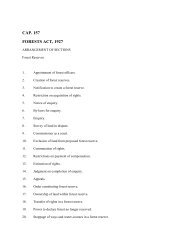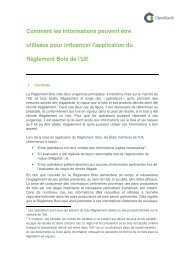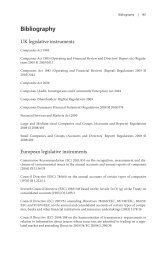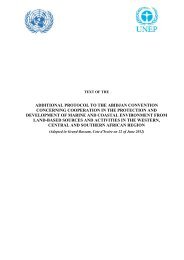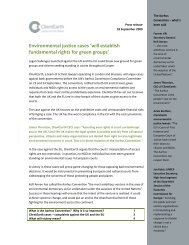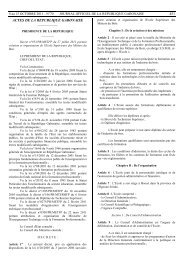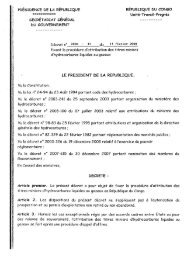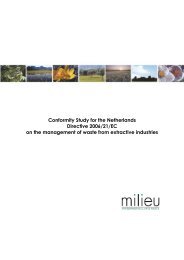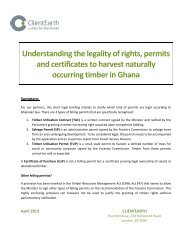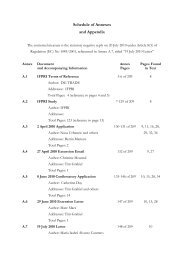Environmental and social transparency under the ... - ClientEarth
Environmental and social transparency under the ... - ClientEarth
Environmental and social transparency under the ... - ClientEarth
- No tags were found...
Create successful ePaper yourself
Turn your PDF publications into a flip-book with our unique Google optimized e-Paper software.
54 | <strong>Environmental</strong> <strong>and</strong> <strong>social</strong> <strong>transparency</strong> <strong>under</strong> <strong>the</strong> Companies Act 2006Chapter 3: <strong>Environmental</strong> <strong>and</strong> <strong>social</strong> issues: Business issues | 55As well as being economically expensive, <strong>the</strong>ir extraction is also extremelycontroversial, primarily due to environmental impacts such as: significantlyhigher greenhouse gas emissions than conventional sources (by someestimates production from tar s<strong>and</strong>s generates an average of three timesmore GHG emissions than conventional crude); 167 associated l<strong>and</strong> <strong>and</strong> ecosystemdamage from strip mining; 168 extremely high water use <strong>and</strong> riverdiversion; 169 <strong>and</strong> potentially considerable issues relating to pollution fromextraction tailings. 170 There are also considerable <strong>social</strong> issues regarding<strong>the</strong> impacts that <strong>the</strong> rush of activity has had on local infrastructure <strong>and</strong> <strong>the</strong>quality of life in areas of intensive speculation <strong>and</strong> operations. 171Tougher regulation now looms on account of <strong>the</strong> <strong>social</strong> <strong>and</strong> environmentalimpacts of <strong>the</strong> activity, <strong>and</strong> <strong>the</strong> companies st<strong>and</strong> to lose significantly, withcapital-intensive assets likely to be left str<strong>and</strong>ed in a regulatory environmentwhich cannot necessarily yield <strong>the</strong> projected profits which justifiedinvestment.Three key sources of pressure for regulatory intervention in Canada:- Local discontent with <strong>the</strong> impacts of operations on <strong>social</strong> infrastructurein <strong>the</strong> locality. 172- Specific international pressure on Canada due to <strong>the</strong> environmentalimpacts of tar s<strong>and</strong>s operations, induced by <strong>the</strong> high profile operationsof major companies. In <strong>the</strong> USA, <strong>the</strong> key market place for <strong>the</strong> product,discomfort with tar s<strong>and</strong>s production is becoming more <strong>and</strong> morevisible, 173 <strong>and</strong> protests have been proliferating. 174- Broad international pressure <strong>and</strong> movement on climate change,which is likely to lead to stronger emissions reduction commitments inCanada. As tar s<strong>and</strong>s projects play a huge role in Canada’s emissionsgrowth, <strong>the</strong>y will become <strong>the</strong> focus of tighter regulation as <strong>the</strong> urgencysurrounding climate change deepens. 175There is also an additional indirect regulatory risk, in that fuel derived fromtar s<strong>and</strong>s faces emissions regulation in California, a major market, whichtakes account of <strong>the</strong> entire lifecycle of transport fuels. Florida, Ontario,British Columbia <strong>and</strong> <strong>the</strong> European Union are all developing similar legislationto California, while Oregon <strong>and</strong> Washington are also exploring <strong>the</strong>issue. 176 This has <strong>the</strong> potential to make tar s<strong>and</strong>s operations less <strong>and</strong> lessprofitable.In February 2009, a U.S. coalition representing institutional investors managinga total of $1.9 trillion in assets drew attention to a number of <strong>the</strong>large energy companies extensively involved in <strong>the</strong> tar s<strong>and</strong>s, arguing that<strong>the</strong>y are not adequately dealing with climate-related business impacts fromphysical changes <strong>and</strong> emerging regulation. They called for greater disclosurefrom <strong>the</strong> companies on <strong>the</strong>ir financial exposure <strong>and</strong> response strategiesto climate-related business trends. 177Fur<strong>the</strong>rmore, corporations that demonstrate high st<strong>and</strong>ards of practice<strong>and</strong> <strong>transparency</strong> in relation to <strong>social</strong>, environmental, ethical, <strong>and</strong> health& safety risk management will find <strong>the</strong>mselves receiving much less scrutinyfrom regulatory agencies. This can result in quicker approvals forpermits, fewer inspections, <strong>and</strong> greater strategic flexibility. 178There is also increasingly potential for an international dimension to ‘regulatoryrisk’. An example of this is where international tribunals have recognised<strong>and</strong> upheld <strong>the</strong> human rights of indigenous peoples (which havenot been protected by <strong>the</strong> State), forcing host states to secure those rights<strong>and</strong> <strong>the</strong>reby precipitating regulatory change. This, again as above, canlead to unexpected restrictions on company activity, leaving companieswith significant operational disruption or even <strong>the</strong> need to cease operationsentirely, having invested considerable funds in <strong>the</strong> development <strong>and</strong>establishment of operations in a given area.The Mayanga Awas Tingni community: internationalenforcement of human rightsMayanga Awas Tingni Community v Nicaragua 179 – On 31 August 2001,<strong>the</strong> Inter-American Court of Human Rights ruled to uphold <strong>the</strong> l<strong>and</strong> rightsof <strong>the</strong> Awas Tingni people, where <strong>the</strong> Nicaraguan state had failed to do so,holding that <strong>the</strong> state must secure <strong>the</strong> effective enjoyment of those rights.The Court ordered Nicaragua to: demarcate <strong>and</strong> title <strong>the</strong> l<strong>and</strong>s in accordancewith traditional l<strong>and</strong> <strong>and</strong> resource tenure patterns; refrain from anyaction that might <strong>under</strong>mine <strong>the</strong> Awas Tingni’s interests in those l<strong>and</strong>s;<strong>and</strong> establish an adequate mechanism to secure <strong>the</strong> l<strong>and</strong> rights of all indigenouscommunities of <strong>the</strong> country. It streng<strong>the</strong>ned a contemporary trend ininternational law that empowers indigenous peoples as distinct groups withsecure territorial rights. 180This was a legally binding decision by an international tribunal. The Statewas <strong>the</strong>refore forced to bring in regulatory changes or enforce existing lawsthat would have major implications for any company operations in <strong>the</strong>area.



